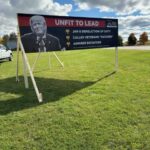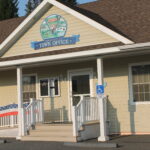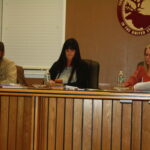Library’s art collections tour humanity’s past, present
 Contributed photo
Contributed photo
Clifton Boudman and the Jaina figures, replicas of Mayan ancestral art on display at the Mark & Emily Turner Memorial Library.
Staff photo/Anthony Brino
The Turner Memorial Library in Presque Isle plans to showcase several hand-carved wooden African ancestral masks were produced in Accra, Ghana more than 100 years ago. They are part of a collection on loan from retired UMPI art professor Clifton Boudman. 
By Anthony Brino
Staff Writer
Clifton Boudman has travelled the world, revelling in the art and history of ancient and modern people and places.
As artist in residence at the Mark & Emily Turner Memorial Library, Boudman is sharing world arts and crafts from his collections and hoping that library visitors will take some time to ponder the exhibits and maybe understand their world a little better.
As winter carries on, the library is preparing to remove the epic book tree in the lobby and use the space to showcase 18 Jaina figures, some of the terracotta replicas from a 3rd century Mayan burial island off Mexico’s Yucatan peninsula. Boudman, a retired art professor from the University of Maine Presque Isle, acquired the figurines along with many other works that he lends for display at the library.
The hand-made and painted Jaina replicas, nearly 100 years old, are based on the ancestor figures found in the Jaina “necropolis,” a limestone island that holds more than 10,000 tombs.
“They’re beautiful,” Boudman said of the figurines — simple, symmetrical, subtly colored, with carved designs and elements of nature, such as a turtle necklace. “When you start with imagery, you start with an idea, then some kind of form, then from that form, there may be content.”
For Boudman and others, Mayan art and history combines the unique designs that evolved in the Americas before European contact with the sober acknowledgement that violence and economic inequality were ways of life, as in many societies at the time (and even today).
Held in the hands of the deceased Mayan elites, the figures “suggest an emphasis on different types of blood sacrifices,” Boudman said. “To understand the early cycles of the world, they went through continual blood sacrifice. Your team loses the soccer game? Part of the sacrifice.”
The ancient Maya civilization originated around 3,000 years ago and lasted through the 1600s, after political rulers collapsed and civil wars started in the 9th century and after the Spanish came to occupy central America. The Maya have long-fascinated artists, archeologists and historians, in part because their society was relatively complex, with cities built through masonry architecture, trade networks, a writing system, astronomy, as well as religious customs that merged worship and human sacrifice.
Part of what Boudman also finds interesting in the Maya is how their culture shares some universal themes with others, past and present.
“There are many societies that incorporated the blood ritual, for a variety of reasons,” Boudman said. “We have a connection with blood ritual today. If you go to (Catholic) Church on Sunday, you drink the blood of Christ and eat his flesh,”
In the past 20 years, the Mayan language has been deciphered, so researchers are now gaining more understanding into the central American society, and Boudman said he’s anticipating new books that explore the society in a fuller context.
Another exhibit at the library showcases traditional artworks from Africa that were among the major influences on the style of cubism and in turn some of the most recognizable paintings in the world — notably Pablo Picasso’s.
Boudman’s hand-carved wooden African ancestral masks were produced in Accra, Ghana more than 100 years ago, and now grace the walls of the library’s 2nd Street Gallery, displaying the range of human emotions in subtle abstractions and deep colors.
In the west African societies, the masks were made in a craft passed on from fathers to sons to tell the stories of their families, and they were used in song and dance to connect with others.
“When a person puts on the mask, you become whatever that ancestor suggests,” Boudman said.
Among those who found these kinds of African masks inspiring were painters Pablo Picasso and André Derain. Although the masks came to be acquired by western museums through the age of colonialism, artists like Picasso “found these to be the most fascinating art of any kind,” Boudman said.
“They had hundreds of these in their studios, and the expressiveness and the strength of the pieces they took to create a lot of modern art,” Boudman said.
One potential lesson from Picasso drawing on influences from another, older culture to create something new, is to visit a museum or library, Boudman said. “Artists used to learn from museums a lot more than they do today.” The African masks, he said, are “great especially for young people, who can see these designs and work with them.”






